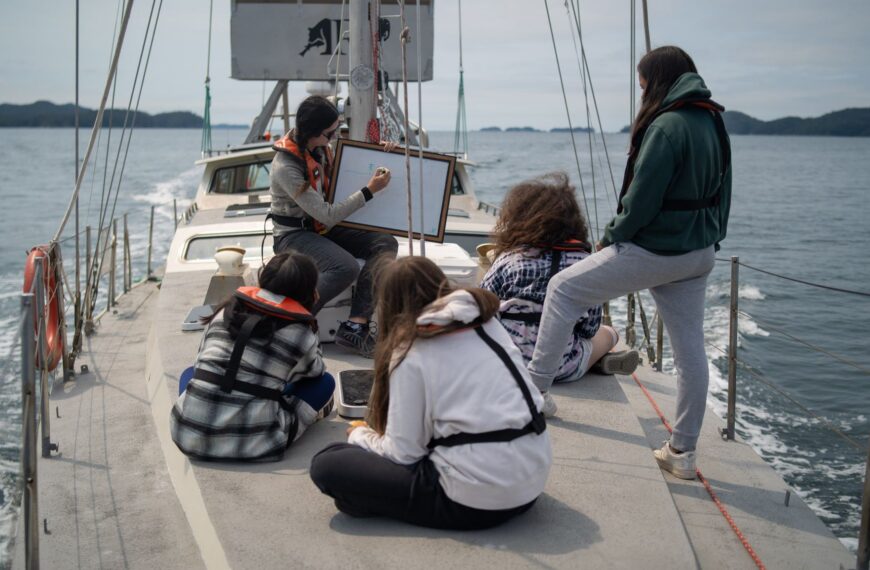Spatial alignment between grizzly bear genetic groups and Indigenous language families in coastal BC
People from Gitga’at, Haíɫzaqv (Heiltsuk), Wuikinuxv, Nuxalk, and Kitasoo/Xai’xais territories have long been connected culturally to grizzly bears. New research from a collaboration among these First Nations and scientists from the University of Victoria and Raincoast Conservation Foundation has revealed a newly identified link in this long-established relationship.
In the landscape on the central coast of what is now known as British Columbia, genetic analyses have identified three distinct genetic groups of grizzly bears.
The spatial areas of these groups align strikingly well with the geographies of three Indigenous language families (Tsimshian, Northern Wakashan, Salishan Nuxalk).
The explanation the research partnership favours is that the landscape has shaped bears and humans in similar ways.
Henson, L. H., N. Balkenhol, R. Gustas, M. Adams, J. Walkus, W. G. Housty, A. V. Stronen, J. Moody, C. Service, D. Reece, B. M. vonHoldt, I. McKechnie, B. F. Koop, and C. T. Darimont. 2021. Convergent geographic patterns between grizzly bear population genetic structure and Indigenous language groups in coastal British Columbia, Canada. Ecology and Society 26(3):7.
https://doi.org/10.5751/ES-12443-260307
How exactly the three areas differ, likely in constraints and opportunities in foods and movement, remains a mystery. However, we do know that bears and people have shared resources and space on this landscape for millennia, emphasizing the potential for a parallel response to variation in these resources that reflects this long-term relationship. This striking finding was unexpected.
“The study was originally motivated towards understanding if genetic discontinuity might exist across the landscape, an important consideration in management. The geographic configuration of the genetic groups does not align with how grizzlies are currently spatially managed by the provincial government.”
— Lauren Henson, Raincoast Fellow and PhD student at UVic
For William Housty, of the Heiltsuk Integrated Resource Management Department and co-author, results like these highlight the importance of locally-led monitoring for management.
“Our investments in research across our territories allow us to make informed management decisions that draw not only from our own knowledge, but also new scientific evidence like this.”
— William Housty, of the Heiltsuk Integrated Resource Management Department
Abstract
Landscape genetic analyses of wildlife populations can exclude variation in a broad suite of potential spatiotemporal correlates, including consideration of how such variation might have similarly influenced people over time. Grizzly bear (Ursus arctos) populations in what is now known as coastal British Columbia, Canada, provide an opportunity to examine the possible effects of a complex set of landscape and human influences on genetic structure. In this collaboration among the Nuxalk, Haíɫzaqv, Kitasoo/Xai’xais, Gitga’at, and Wuikinuxv First Nations and conservation scientists, we characterized patterns of genetic differentiation in the grizzly bear, a species of high cultural value, by genotyping 22 microsatellite loci from noninvasively collected hair samples over a 23,500 km² area. We identified three well-differentiated groups. Resistance surfaces, which incorporated past and present human use, settlement, and landscape resistant features, could not explain this pattern of genetic variation. Notably, however, we detected spatial alignment between Indigenous language families and grizzly bear genetic groups. Grizzly bears sampled within an area represented by a given language family were significantly similar to those sampled within that language family (P = 0.001) and significantly divergent to those sampled outside the language family (P = 0.001). This spatial co-occurrence suggests that grizzly bear and human groups have been shaped by the landscape in similar ways, creating a convergence of grizzly bear genetic and human linguistic diversity. Additionally, grizzly bear management units designated by the provincial government currently divide an otherwise continuous group and exclude recently colonized island populations that are genetically continuous with adjacent mainland groups. This work provides not only insight into how ecological and geographic conditions can similarly shape the distribution of people and wildlife but also new genetic evidence to support renewed, locally led management of grizzly bears into the future.
Select figures
Figure 1

Figure 2

Author affiliations
Department of Geography, University of Victoria
Raincoast Conservation Foundation
Wildlife Sciences, Faculty of Forest Sciences, University of Goettingen
Department of Anthropology, University of Victoria
Department of Forest and Conservation Sciences, University of British Columbia
Council, Wuikinuxv First Nation
Haíɫzaqv Integrated Resource Management Department
Department of Biology, University of Ljubljana
Department of Biotechnology and Life Sciences, Insubria University
Nuxalk Stewardship Office
Kitasoo/Xai’xais Stewardship Authority
Gitga’at Oceans and Lands Department
Department of Ecology and Evolutionary Biology, Princeton University
Hakai Institute
Department of Biology, University of Victoria
You can help
Raincoast’s in-house scientists, collaborating graduate students, postdoctoral fellows, and professors make us unique among conservation groups. We work with First Nations, academic institutions, government, and other NGOs to build support and inform decisions that protect aquatic and terrestrial ecosystems, and the wildlife that depend on them. We conduct ethically applied, process-oriented, and hypothesis-driven research that has immediate and relevant utility for conservation deliberations and the collective body of scientific knowledge.
We investigate to understand coastal species and processes. We inform by bringing science to decision-makers and communities. We inspire action to protect wildlife and wildlife habitats.










